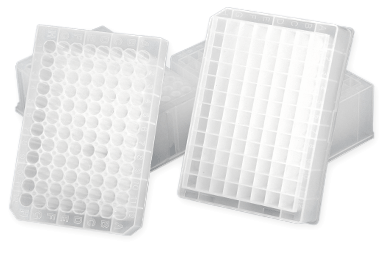Protein Crash Plate and Protein Precipitation

An organic solvent, acid, salt, and metal have been used for effecting protein precipitation by exerting specific interactive effects on the protein structure. An organic solvent lowers the dielectric constant of the blood protein solution and also displaces the ordered water molecules around the hydrophobic regions on the protein surface, the former enhancing electrostatic attractions among charged protein molecules and the latter minimizing hydrophobic interactions among the proteins. Thus, the proteins aggregate and precipitate.
Acidic reagents form insoluble salts with the positively charged amino groups of the proteins at pH values below their isoelectric points (pIs). High salt concentrations deplete water molecules from the hydrophobic protein surfaces and allows aggregation through hydrophobic interactions of protein molecules. Binding of metal ions reduces protein solubility by changing its pI. Variation in ionization effects for different species of plasma using acetonitrile in 50:50 methanol:water is also a good choice. Here is the summary of some study results:
- The most efficient precipitants for protein removal were zinc sulfate, acetonitrile, and trichloroacetic acid (at 2:1 volume of precipitant to plasma, the protein removal values were, respectively, 96, 92, and 91% with <1% RSD for n = 5).
- The chosen precipitants functioned universally for all plasmas.
- Using acidic components exerted significant effects on ionization efficiency.
- Pure mobile phases with organic precipitants produced the largest ionization effects.
Orochem's Protein crash and protein precipitate filter products allow simple, rapid and high throughput sample preparation.
The graded frit design is optimized to efficiently remove precipitated protein without plugging or breakthrough. Protein precipitation can be accomplished in-situ in the plate wells, minimizing sample handling. Protein precipitate is removed by filtration, eliminating time consuming centrifugation and transfer steps.
Features
- Available both cartridge and 96-well plate formats. Both can be used with positive pressure processor, vacuum manifold, or centrifuge.
- Protein crash kit has one protein crash plate, one collection plate and one cap mat.
- No solvent leakage during mixing, incubation and zero crosstalk.
Showing all 10 results
- Catalog#
- Description
-
Description
Protein crash, 96-well plate, RubyPro, 2.0 ml, 1/pkg
-
Description
Protein crash, 96-well plate, RubyPro, 2.0 ml, 10/pkg
-
Description
Protein crash, 96-well plate, RubyPro, 2.0 ml, 25/pkg
-
Description
Protein crash, 96-well plate, RubyPro, 2.0 ml, 5/pkg
-
Description
Protein crash, 96-well plate, RubyPro, 2.0 ml, 50/pkg
-
Description
Protein crash, 96-well plate, RubyPro, 1.0 ml, 1/pkg
-
Description
Protein crash, 96-well plate, RubyPro, 1.0 ml, 10/pkg
-
Description
Protein crash, 96-well plate, RubyPro, 1.0 ml, 25/pkg
-
Description
Protein crash, 96-well plate, RubyPro, 1.0 ml, 5/pkg
-
Description
Protein crash, 96-well plate, RubyPro, 1.0 ml, 50/pkg
| AQUAMATRIX SLLE | File size: 376KB | Download |
| RUBYPRO Protein Crash | File size: 846KB | Download |
| Protein-Crash-Plates | File size: 76KB | Download |
